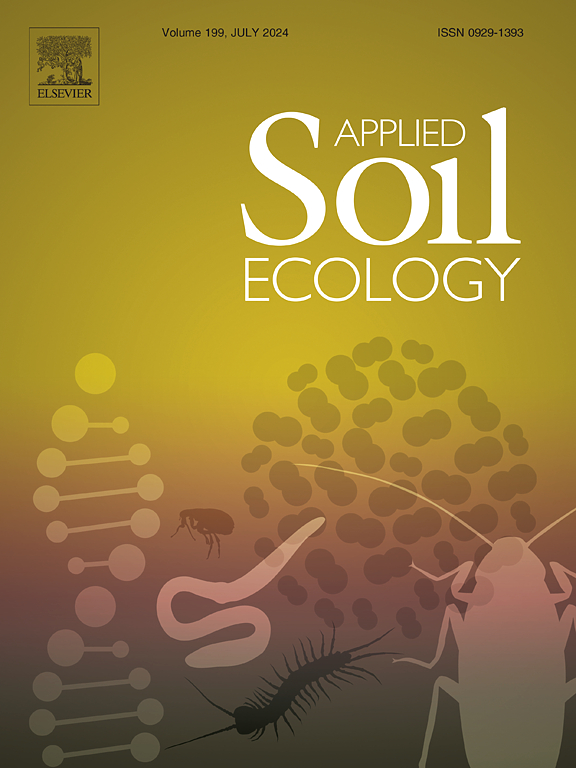Combined effects of biochar and silkworm excrement compost applications on soil properties and vegetable growth
IF 4.8
2区 农林科学
Q1 SOIL SCIENCE
引用次数: 0
Abstract
With the growing global population, the demand for vegetables is increasing rapidly. While the extensive use of chemical fertilizers has been a conventional approach to boost vegetable production, it often degrades soil health and diminishes vegetable quality. This study evaluates the potential of rice husk biochar and silkworm excrement compost as alternative, sustainable biomass fertilizers, examining their impact on yield, quality, soil fertility, and soil microbial communities in Chinese cabbage and lettuce cultivation. Results demonstrated that a combined application of biochar and silkworm excrement compost significantly enhanced the yields of both Chinese cabbage and lettuce. The optimal yield for each crop was achieved at a biochar-to-compost ratio of 2:3, and yields (fresh weight) after this treatment were134 and 103 times higher than the control for Chinese cabbage and lettuce, respectively. In addition, by adjusting the combination ratio of compost and biochar, indicators such as vitamin C, soluble sugar, and soluble protein can be effectively improved, thereby enhancing the quality of vegetables. Compared to control, soil ammonium nitrogen, nitrate nitrogen, available phosphorus, and available potassium showed marked increases in all other treatment soils. In Chinese cabbage soil, compared to other fertility indicators, the highest increase in available phosphorus was observed under biochar-to-compost ratio of 2:3 treatment with an increment of 175.2 % over the control. Furthermore, the biochar-compost combination enhanced soil microbial community structure, raised the Alpha diversity index for soil bacteria, and increased the abundance of key phyla, including Proteobacteria and Actinobacteria. These findings offer new insights and methodological support for advancing sustainable practices within the vegetable industry.
生物炭与蚕粪混合施用对土壤性状和蔬菜生长的影响
随着全球人口的增长,对蔬菜的需求正在迅速增加。虽然大量使用化肥一直是提高蔬菜产量的传统方法,但它往往会使土壤健康恶化,降低蔬菜质量。本研究评估了稻壳生物炭和蚕粪堆肥作为可替代的、可持续的生物质肥料的潜力,研究了它们对白菜和生菜产量、质量、土壤肥力和土壤微生物群落的影响。结果表明,生物炭与蚕粪堆肥配合施用可显著提高大白菜和生菜的产量。当生物炭与堆肥的比例为2:3时,每一种作物的最佳产量分别比对照高134倍和103倍(鲜重)。此外,通过调整堆肥与生物炭的组合比例,可有效提高维生素C、可溶性糖、可溶性蛋白等指标,从而提高蔬菜品质。与对照相比,各处理土壤铵态氮、硝态氮、速效磷和速效钾均显著增加。在白菜土中,与其他肥力指标相比,在生物炭与堆肥比例为2:3的处理下,速效磷的增幅最大,比对照增加了175.2%。此外,生物炭-堆肥组合改善了土壤微生物群落结构,提高了土壤细菌的α多样性指数,增加了关键门的丰度,包括变形菌门和放线菌门。这些发现为促进蔬菜产业的可持续实践提供了新的见解和方法支持。
本文章由计算机程序翻译,如有差异,请以英文原文为准。
求助全文
约1分钟内获得全文
求助全文
来源期刊

Applied Soil Ecology
农林科学-土壤科学
CiteScore
9.70
自引率
4.20%
发文量
363
审稿时长
5.3 months
期刊介绍:
Applied Soil Ecology addresses the role of soil organisms and their interactions in relation to: sustainability and productivity, nutrient cycling and other soil processes, the maintenance of soil functions, the impact of human activities on soil ecosystems and bio(techno)logical control of soil-inhabiting pests, diseases and weeds.
 求助内容:
求助内容: 应助结果提醒方式:
应助结果提醒方式:


